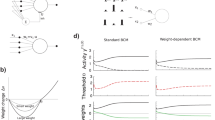Abstract
In this work we present a neural network model incorporating activity-dependent presynaptic facilitation with multidimensional inputs. The processing unit used is based on a slightly simplified version of the Learning Gate Model proposed by Ciaccia et al. (1992). The network topology integrates a well-known biological neural circuit with a lateral inhibition connection subnet. By means of simulation experiments, we show that the proposed networks exhibit basic and high-order features of associative learning. In particular, overshadowing and blocking are reproduced in the presence of both noise-free and noisy inputs. The role of noise in the development of high-order learning capabilities is also discussed.
Similar content being viewed by others
References
Bailey CH, Chen M (1988) Long-term memory in Aplysia modulates the total number of varicosities of single identified sensory neurons. Proc Nat Acad Sci USA 85:2373–2377
Buonomano DV, Byrne JH (1990) Long-term synaptic changes produced by a cellular analog of classical conditioning in Aplysia. Science 249:420–423
Buonomano DV, Baxter DA, Byrne JH (1990) Small networks of empirically derived adaptive elements simulate some higher-order features of classical conditioning. Neural Networks 3:507–523
Byrne JH (1987) Cellular analysis of associative learning. Physiol Rev 67:329–439
Byrne JH, Eskin A, Scholz KP (1989) Neuronal mechanisms contributing to long-term sensitization in Aplysia. J Physiol 83:141–147
Byrne JH, Baxter DA, Buonomano DV, Raymond JL (1990) Neuronal and network determinants of simple and higher-order features of associative learning: experimental and modeling approach. Cold Spring Harbor Symp Quant Biol 55:175–186
Carpenter GA, Grossberg S (1990) ART3: Hierarchical search using chemical transmitters in self-organizing pattern recognition architectures. Neural Networks 3:129–152
Castellucci VF, Kandel ER (1976) Presynaptic facilitation as a mechanism for behavioral sensitization in Aplysia. Science 94:1176–1178
Ciaccia P, Maio D, Vacca GP (1992) An analytical short-and long-term memory model of presynaptic plasticity. Biol Cybern 67:335–345
Gingrich KJ, Byrne JH (1985) Simulation of synaptic depression, posttetanic potentiation, and presynaptic facilitation of synaptic potentials from sensory neurons mediating gill-withdrawal in Aplysia. J Neurophysiol 53:652–669
Gingrich KJ, Byrne JH (1987) Single-cell neuronal model for associative learning. J Neurophysiol 57:1705–1715
Gingrich KJ, Baxter DA, Byrne JH (1988) Mathematical model of cellular mechanisms contributing to presynaptic facilitation. Brain Res Bull 21:513–520
Gluck MA, Thompson RF (1987) Modeling the neural substrates of associative learning and memory: a computational approach. Psychol Rev 94:176–191
Grossberg S, Levine DS (1987) Neural dynamics of attentionally modulated Pavlovian conditioning: blocking, interstimulus interval, and secondary reinforcement. Appl Optics 26:5015–5030
Hawkins RD (1989a) A biologically based computational model for several simple forms of learning. In: Hawkins RD, Bower GH (eds) Computational models of learning in simple neural systems. Academic Press, San Diego
Hawkins RD (1989b) A biologically realistic neural network model for higher-order features of classical conditioning. In: Morris RGM (eds) Parallel distribuited processing, implications for psychology and neurology. Clarendon Press, Oxford
Hawkins RD, Kandel ER (1984) Is there a cell-biological alphabet for simple forms of learning? Psychol Rev 91:375–391
Hawkins RD, Abrams TW, Carew TJ, Kandel ER (1983) A cellular mechanism of classical conditioning in Aplysia: activity-dependent amplification of presynaptic facilitation. Science 219:400–405
Kandel ER, Schwartz JH (1982) Molecular biology of learning: modulation of transmitter release. Science 218:433–443
Kandel ER, Abrams TW, Bernier L, Carew TJ, Hawkins RD (1983) Classical conditioning and sensitization share aspects of same molecular cascade in Aplysia. Cold Spring Harbor Symp Quant Biol 48:821–830
Kohonen T (1984) Self-organization and associative memory. Springer, Berlin Heidelberg New York.
Mackintosh NJ (1974) The psychology of animal learning. Academic Press, London
Rescorla RA, Wagner AR (1972) A theory of Pavlovian conditioning: variations in the effectiveness of reinforcement. In: Black AH, Prokasy VF (eds) Classical conditioning II: current research and theory. Appleton-Century-Crofts, New York, pp 64–99
Small SA, Kandel ER, Hawkins RD (1989) Activity-dependent enhancement of presynaptic inhibition in Aplysia sensory neurons. Science 243:1603–1606
Sutton RS, Barto AG (1990) Time-derivative models of Pavlovian reinforcement. In: Gabriel M, Moore JW (eds) Learning and computational neuroscience. MIT Press, Cambridge, Mass.
Walters ET, Byrne JH (1983) Associative conditioning of single sensory neurons suggests a cellular mechanism for learning. Science 219:405–408
Witt JC, Clark JW (1990) Experiments in artificial psychology: conditioning f asynchronous neural networks models. Math Biosci 99:77–104
Yuille AL, Grzywacz NM (1993) A winner-take-all mechanism based on presynaptic inhibition feedback. Neural Comput 1:334–347
Author information
Authors and Affiliations
Corresponding author
Additional information
This article was processed by the author using the LATEX style file pljour2 from Springer-Verlag.
Rights and permissions
About this article
Cite this article
Blanzieri, E., Grandi, F. & Maio, D. High-order behaviour in learning gate networks with lateral inhibition. Biol. Cybern. 74, 73–83 (1996). https://doi.org/10.1007/BF00199139
Received:
Accepted:
Issue Date:
DOI: https://doi.org/10.1007/BF00199139




